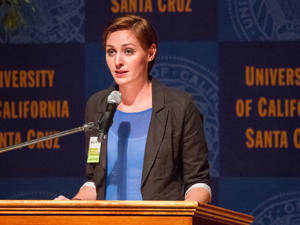The last thing Helen Porter expected when she came to UC Santa Cruz was to find herself in Japan researching the history behind 200 photos taken by an Army dentist.
But that's where the San Francisco resident and dancer landed last year. Porter, a 22-year-old history major and Kresge College student who will graduate in June, was part of a unique undergraduate research project at UCSC, called The Gail Project, that is exploring the complicated world of Okinawa in the 1950s through a series of photos taken by a U.S. serviceman named Charles Gail.
One day, the photos will not only be part of a traveling exhibit that chronicles the story of a people whose lives and society were upended by war but will also serve as a bridge between students at UCSC and their counterparts on the Japanese island.
"It's a topic," said Porter, "that's really underexplored. What we want to do is provide a forum for discussion about something that is still an issue right now."
Porter's path to this slice of history was a circuitous one. She came to UCSC thinking she would go to law school. A freshman history class on the Middle East taught by Professor Terry Burke shifted her focus, however. Alerted to a senior seminar on the Gail photos being taught by Associate Professor of East Asian Studies Alan Christy, Porter, now a history major, dove into the project.
As Porter spoke, she clicked through a slide show of Gail's black-and-white photos, which captured fishermen and shopkeepers at work in post-war Okinawa, rain-black ocean squalls, and a laughing old woman holding a small child.
The photos, she explained, were taken after Gail arrived in Okinawa in 1951 to run an Army hospital. It was a time when the expansion of U.S. military bases on the war-ravaged island was beginning to ramp up. The photos Gail took documented a way of life that would soon disappear, a last glimpse of a time before the presence of thousands of military personnel and U.S. influence changed the face of Okinawa. The pictures had been donated to UCSC Special Collections by Gail's daughter, Geri Gail, in 2013.
Porter, who was doing a concentration on Latin America at the time, soon fell under the spell of the images. They inspired her to research a little-known piece of history: the relocation of those of Okinawan ancestry from their homes in Peru to U.S. internment camps during WWII, where, when the war ended, they were declared illegal immigrants and shipped to Okinawa, a land completely foreign to them. A research trip to Japan, supported by grants and student fundraising, yielded even more information.
"Her research was very important to the project," Christy said. "It showed Okinawa was not an isolated, tiny island but that it had a global perspective of its own."
"What I love about the project is that it is so collaborative," said Porter, who became co-director of the undertaking. Each student in the seminar brought their own skills and interests to the project, working on web pages, video or research into topics as varied as land ownership and crime on the island. Like other students, Porter was so passionate about the project she continued to work on it even as she choreographed and danced in two UCSC performances.
Porter, who will graduate in June and move back to San Francisco, said she hopes to continue to work on The Gail Project, even as a new class of students arrives in the fall to add to the venture. Christy, meanwhile, is organizing a collaboration between UCSC students and those at the University of Ryukyu and Meio University in Okinawa in order to do more research on residents in the photos, many of whom may still be alive.
The project will culminate in a traveling exhibition to Okinawa, Honolulu, and Los Angeles, among other places, and Porter hopes to be there for the unveiling, even as she pursues her vision of teaching abroad someday.
The exhibit's time period, Porter said, "is a template for other occupations and wars. I think it's a history project but it is also relevant now."



